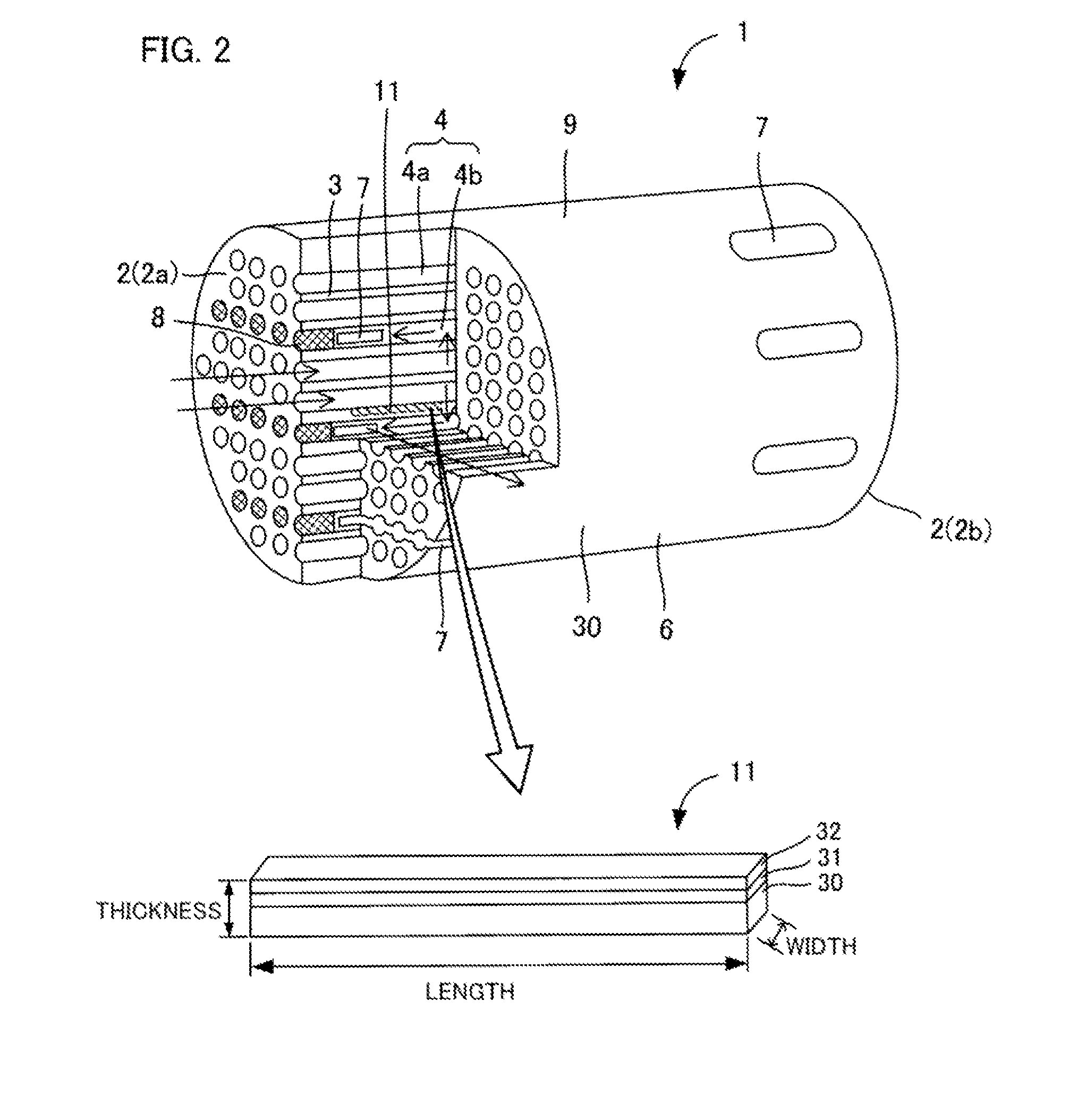Zeolite membrane regeneration method
a zeolite membrane and regeneration method technology, applied in the direction of membranes, other chemical processes, separation processes, etc., can solve the problems of water molecules affecting the permeation amount and reducing the permeation amount, so as to reduce the separation coefficient and restore the permeation amount of the zeolite membrane
- Summary
- Abstract
- Description
- Claims
- Application Information
AI Technical Summary
Benefits of technology
Problems solved by technology
Method used
Image
Examples
examples
[0069]The present invention will be described in further detail with reference to examples, but the present invention is not limited to these examples.
[0070]1. Method for Preparing Monolith Type Separation Membrane Structure
[0071]Monolith type substrates 30 were prepared, and separation membranes 33 (zeolite membranes) were formed in the cells 4 thereof. First, the preparation of the substrates 30 will be described.
[0072](Substrate)
[0073]To 100 parts by mass of alumina particles (aggregate particles) of 50 μm in average particle diameter, 20 parts by mass of inorganic bonding material (sintering aid) was added, and water, dispersing agent, and thickener were further added, mixed and kneaded to prepare a kneaded material. The obtained kneaded material was extruded to prepare a monolith type unfired substrate 30.
[0074]Then, the substrate 30 was subjected to firing. The firing condition was 1250° C. for 1 hour, and the rates of temperature increase and temperature decrease were both 10...
examples 1 to 8
, Comparative Examples 1 to 2
Formation of DDR Membranes
[0077]As separation membranes 33, DDR membranes were formed on the inner wall faces 4s of the cells 4.
[0078](1) Preparation of Seed Crystals
[0079]Based on the method for producing DDR-type zeolite as set forth in M. J. den Exter, J. C. Jansen, H. van Bekkum, Studies in Surface Science and Catalysis vol. 84, Ed. by J. Weitkamp et al., Elsevier (1994) 1159-1166 or JP-A-2004-083375, a DDR-type zeolite crystal powder was produced, directly, or if necessary, subjected to grinding, and used as seed crystals. The synthesized or ground seed crystal was dispersed in water, and coarse particles were then removed to prepare a seed crystal dispersion liquid.
[0080](2) Seed Attachment (Particle Adhesion Step)
[0081]The seed crystal dispersion liquid prepared in the step (1) was diluted with ion-exchanged water or ethanol, and adjusted so that the DDR concentration was 0.001 to 0.36 mass % (the solid content concentration in the slurry), and st...
example 1
[0100]The heat treatment condition was adapted to the rate of temperature increase: 25° C. / h, the maximum temperature: 100° C., and keeping time: 1 h in an air atmosphere furnace. The separation performance after the heat treatment was not degraded, while the permeation amount recovery rate was 109%.
PUM
| Property | Measurement | Unit |
|---|---|---|
| temperature | aaaaa | aaaaa |
| length | aaaaa | aaaaa |
| diameter | aaaaa | aaaaa |
Abstract
Description
Claims
Application Information
 Login to View More
Login to View More - R&D
- Intellectual Property
- Life Sciences
- Materials
- Tech Scout
- Unparalleled Data Quality
- Higher Quality Content
- 60% Fewer Hallucinations
Browse by: Latest US Patents, China's latest patents, Technical Efficacy Thesaurus, Application Domain, Technology Topic, Popular Technical Reports.
© 2025 PatSnap. All rights reserved.Legal|Privacy policy|Modern Slavery Act Transparency Statement|Sitemap|About US| Contact US: help@patsnap.com



